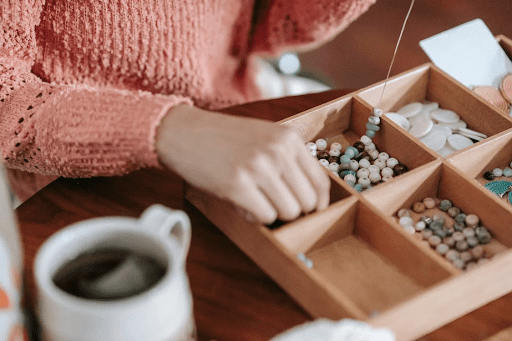Sparkle and Shine: Transforming Your Creations with Beadwork
Introduction to Beadwork
Beadwork is a timeless craft that has captivated cultures around the world for centuries. From intricate jewelry to ornate tapestries, beadwork encompasses a wide range of artistic expressions that continue to inspire and enchant people to this day.

Definition and Historical Significance
Beadwork refers to the art of creating decorative or functional items by stringing beads onto a surface, typically using thread, wire, or other materials. The practice of beadwork dates back thousands of years and holds significant cultural and symbolic meanings for many indigenous peoples and civilizations.
Beads have been used for various purposes throughout history, including adornment, ritual, trade, and storytelling. In ancient civilizations such as Egypt, Mesopotamia, and China, beads were highly valued and often reserved for royalty or religious ceremonies. They were crafted from a wide range of materials, including glass, metal, bone, shell, and gemstones.
Evolution of Beadwork Techniques
Over time, beadwork techniques have evolved and diversified, reflecting the influence of different cultures, technological advancements, and artistic innovations. Some of the most notable beadwork techniques include:
- Native American Beading: Indigenous tribes in North America developed intricate beadwork traditions using techniques such as beadweaving looms, and basic of peyote stitch. These techniques were passed down through generations and continue to be practiced today, preserving cultural heritage and artistic expression.
- European Beadwork: In Europe, beadwork flourished during the Victorian era, with intricate bead embroidery adorning clothing, accessories, and home decor items. Tambour beading, a technique using a specialized hook to attach beads to fabric, became particularly popular during this time.
- Contemporary Beadwork: In modern times, beadwork has experienced a resurgence in popularity as artists and designers explore new materials, techniques, and styles. Contemporary beadwork encompasses a wide range of forms, including jewelry making, textile art, sculpture, and mixed media collage.
Materials and Tools: Unveiling the Beadworker’s Arsenal
Type of beads: From Glass to Gemstones

The heart of any beadwork project lies in the type.of.beads you choose. Beads come in a dazzling array of materials, shapes, sizes, and finishes, each offering unique design possibilities.
- Glass Beads: Versatile and affordable, glass beads are available in a wide range of beads like chevron beads, pony beads, millefiori beads.
- Seed Beads: Small, uniform glass beads commonly used in bead weaving and embroidery.
- Semi-precious Gemstone Beads: Beads made from materials like amethyst, turquoise, and jade add natural beauty and depth to beadwork.
- Ceramic Beads: Durable and available in various shapes and finishes, ceramic beads offer a unique textural element.
- Metal Beads: Brass, copper, and silver beads can add a touch of metallic shine and warmth to your designs.
- Wooden Beads: Earthy and rustic, wooden beads are perfect for creating bohemian-inspired jewelry, home decor, and accessories.
- Acrylic Beads: Lightweight and affordable, acrylic beads come in a variety of shapes and colors, making them ideal for crafting fun and playful designs.
Threads and Needles: Choosing the Right Supplies
The threads and needles you use for beadwork are just as important as the beads themselves. Here are some common options.
- Beading Threads: Nylon, silk, or polyester threads designed specifically for beadwork, such as Nymo, Fireline, or KO thread, provide strength and durability.
- Needles: Beading needles come in various sizes and types, including English beading needles, sharps, and milliners, each suited for different beading techniques and bead sizes.
Additional Tools and Equipment for Beadwork
- Bead Mats or Trays: These help keep your beads organized and prevent them from rolling away while you work.
- Bead Looms: Looms are essential for loom beadwork, allowing you to create intricate woven patterns and structures.
- Scissors: A pair of sharp, precise scissors is necessary for trimming threads and cutting materials.
- Magnification Tools: Lighted magnifiers or jeweler’s loupes can help you see the tiny details of your beadwork more clearly.
- Bead Stoppers or Thread Conditioners: These accessories help secure your thread and prevent beads from sliding off.
Traditional Beadwork Techniques: A Legacy Woven Through Time
Beadwork has a rich history rooted in traditional techniques that have been passed down through generations. From loom beading to intricate Native American and African beadwork, these traditional methods showcase the cultural significance and artistic expression of beadwork around the world.
Loom Beading: Ancient Method with Modern Adaptations

Loom beading, a technique with roots dating back centuries, utilizes a loom to create intricate and colorful beadwork. Threads are strung on the loom’s frame, and beads are meticulously woven onto these threads, following specific patterns.
Traditional Techniques
- Backstrap Loom: This traditional loom is worn by the weaver, offering portability and control.
- Bead Weaving Loom: This stationary loom comes in various sizes and complexities, allowing for diverse beadwork projects.
Modern Adaptations
While the core principle of loom beading remains the same, modern materials and tools have expanded its possibilities. Synthetic threads offer increased strength and flexibility, and innovative looms with multiple features streamline the weaving process.
Native American Beadwork: Rich Tradition and Symbolism

Native American beadwork is a vibrant art form deeply rooted in cultural heritage and spiritual beliefs. Beads, often made from natural materials like shells or bones, were not merely decorative; they held symbolic significance, representing social status, religious beliefs, or even tribal stories.
Traditional Techniques
- Off-Loom Beadwork: This technique involves stitching beads directly onto a fabric or leather base using needles and thread.
- Brick.stitch: This popular stitch creates a strong and versatile foundation for geometric patterns and intricate beadwork designs.
Modern Adaptations
Today, Native American beadwork continues to thrive as artisans honor traditional techniques while incorporating contemporary elements and materials. From powwow regalia to contemporary art pieces, Native American beadwork remains an integral part of indigenous culture and artistic expression.

African beadwork boasts a dazzling array of styles and techniques, each reflecting the diverse cultures of the continent. Beads, crafted from glass, metal, or even natural materials, played a crucial role in African societies, signifying wealth, status, and spiritual beliefs. While right angle weave isn’t a traditional African beadwork technique, it can be a valuable tool for contemporary beadwork artists who draw inspiration from African aesthetics.
Traditional Techniques
- Bead Embroidery: This widespread technique involves stitching beads onto a fabric base, creating elaborate and colorful designs.
- Waist Beadwork: A prominent tradition in West Africa, waist beads hold cultural and spiritual significance, often marking rites of passage or expressing personal identity.
Modern Adaptations
Contemporary African beadwork artists continue to innovate, incorporating traditional techniques into modern designs. Jewelry, clothing embellishments, and even home décor accents showcase the enduring beauty and cultural richness of African beadwork.
Contemporary Applications of Beadwork: From Adornment to Art
Beadwork, an art form with a rich history, has transcended its traditional roots to find exciting new applications in the contemporary world. This section explores how beadwork is adorning everything from fashion runways to home décor, while also serving as a powerful medium for artistic expression.
Fashion and Jewelry: Beaded Designs on the Runway

Beadwork has made a remarkable comeback in the fashion world. From delicate embellishments to statement pieces, beads are adding a touch of glamour and individuality to contemporary attire.
- Runway Revelations: High-fashion designers are incorporating beadwork into their collections, creating show stopping gowns, intricate bodices, and dazzling accessories.
- Jewelry Renaissance: Beadwork is flourishing in the realm of jewelry. Necklaces, earrings, bracelets, and even rings are adorned with intricate beadwork patterns, adding a touch of handcrafted luxury to any outfit.
- Beyond Luxury: Beadwork isn’t limited to high fashion. Independent designers and artists are creating unique and affordable beaded jewelry pieces, making this art form accessible to a wider audience.
Home Decor: Adding Sparkle and Personality to Spaces

Beadwork is no longer confined to adornment; it’s adding a touch of personality and sparkle to contemporary home décor.
- Embellished Accents: Throw pillows, table runners, and even lampshades are getting a beaded makeover, adding texture and visual interest to living spaces.
- Wall Hangings and Art Installations: Beadwork is finding its place in wall art and installations, creating a unique textural element and a conversation starter in any room.
- Functional with Flair: Beadwork isn’t just about aesthetics. Beaded coasters, placemats, and even drawer pulls add a touch of functionality and personality to everyday household items.
Artistic Expressions: Beadwork as a Medium for Creative Exploration
Beadwork has transcended its traditional utilitarian functions to become a powerful medium for artistic expression.
- Abstract Explorations: Beadwork artists are creating abstract pieces that explore color, texture, and form, pushing the boundaries of this art form.
- Figurative Representations: Beadwork is being used to depict figures, animals, and even landscapes, showcasing the artist’s unique vision and storytelling abilities.
- Wearable Art: The line between jewelry and art blurs as beadwork artists create wearable sculptures and statement pieces that redefine the concept of adornment.
Conclusion
In conclusion, beadwork continues to evolve and adapt, defying expectations and captivating audiences. From adorning fashion runways to gracing art galleries, beadwork’s versatility and enduring beauty ensure its place as a cherished art form for generations to come. So, unleash your creativity, explore the possibilities, and discover the magic of beadwork in its many contemporary applications!

Recent Comments